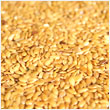Agricultural Products:
Grains and Oilseeds > Flax
Flaxseed
Flax comes from the blue-flowered plant crop grown mainly in the cool, northern climate of the western Canadian prairies. Canadian brown flax seed is the favorite choice of consumers. The omega-3 fatty acid and fibre in flax are nutrients that contribute to wellness.
 For centuries, flax has played an important role in Canadian agriculture. High quality flax as an ingredient in food and many other products has given Canada an edge in world sales and exports of the commodity. For centuries, flax has played an important role in Canadian agriculture. High quality flax as an ingredient in food and many other products has given Canada an edge in world sales and exports of the commodity.
Today, Canada is the world's leader in the production and export of flax - a position it has held since 1994. In the relatively poor crop year of 2004/05, Canada produced about 500,000 t, and exported about 90% of it, according to Statistics Canada . In 2005/06, Canadian flax production totaled 1.035 mt.
One of five major Canadian crops, flax travels today to ports alongside wheat, barley, oats and canola. Canadian flax is exported mainly to Europe, the U.S., Japan and South Korea . Canada currently ships 60% of its flax exports to the EU, 30% to the United States, and 4% to Japan. Flax in Animal and Poultry Feed for Better Health
Flax as animal feed ingredient
Flax is unique in its high alpha-linolenic fatty acid (ALA) content. ALA is an omega-3 fatty acid, which contributes to good animal health. Flax is increasingly used as an ingredient in feeds for improved animal nutrition.
Cattle Rations
Flax in cattle rations is being investigated as a means of improving the immune systems of calves. The benefits of omega-3 fatty acids to cattle may be in preventing young animals from developing infections.
Dairy Cattle Rations
Agriculture and Agri-Food Canada's multidisciplinary team at the Dairy and Swine Research and Development Centre in Lennoxville, Quebec is studying reproductive and milking performance in animals on flax-enhanced rations. Research has shown improved conception rates related to flax in rations.
Hog Rations
The Flax Council has been involved in feeding trials in farrowing sows for improved pig production. Notably, flax rations improved sow fertility, allowing sows to be bred more quickly after weaning, and thereby increased the total number of piglets born over a span of three pregnancies. In addition, piglets born to sows on flax were shown to be heavier and healthier, with a lower mortality rate.
Pet Foods
Many pet food manufacturers include milled flax in their premium pet foods as a source of essential fatty acids. The flax balances the omega-3 and omega-6 fatty acid ratio of the food, and promotes skin and coat health. The flax also contributes lignans, considered safeguards against tumor formation in pets.
Equine Feeds
Many horse breeders and owners add milled, cooked or soaked flax seeds, or flax supplements or treats, to equine diets, especially if the horses are not fed on pasture for much of the year. The balance of omega-3 and omega-6 fatty acids in flax is important for horse health. Due to its high alpha-linolenic content, flax can eliminate dull, dry coats, and the itching and scratching that can accompany them. Flax can also prevent colic in horses.
Industrial uses: Flax within Linseed oil
Protects wood, preserves concrete, and flax fibre strengthens products. (Flax Council of Canada)
|